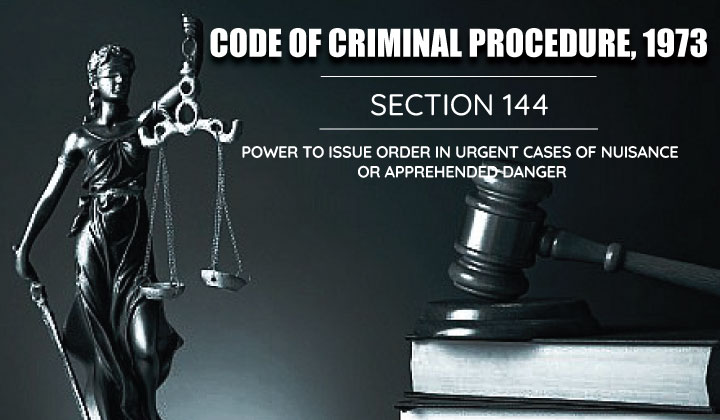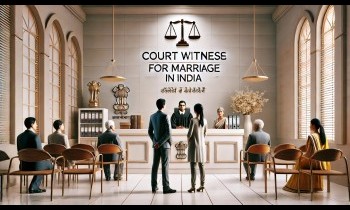Power to Issue Order in Urgent Cases of Nuisance or apprehended Danger - CRPC 144

Date : 05 Apr, 2022
Post By Vishal Kumar
Section 144- Power to issue order in urgent cases of nuisance of apprehended danger. (1) In cases where, in the opinion of a District Magistrate, a Sub- divisional Magistrate or any other Executive Magistrate specially empowered by the State Government in this behalf, there is sufficient ground for proceeding under this section and immediate prevention or speedy remedy is desirable, such Magistrate may, by a written order stating the material facts of the case and served in the manner provided by section 134, direct any person to abstain from a certain act or to take certain order with respect to certain property in his possession or under his management, if such Magistrate considers that such direction is likely to prevent, or tends to prevent, obstruction, annoyance or injury to any person lawfully employed, or danger to human life, health or safety, or a disturbance of the public tranquillity, or a riot, of an affray. (2) An order under this section may, in cases of emergency or in cases where the circumstances do not admit of the serving in due time of a notice upon the person against whom the order is directed, be passed ex parte. (3) An order under this section may be directed to a particular individual, or to persons residing in a particular place or area, or to the public generally when frequenting or visiting a particular place or area. (4) No order under this section shall remain in force for more than two months from the making thereof: Provided that, if the State Government considers it necessary so to do for preventing danger to human life, health or safety or for preventing a riot or any affray, it may, by notification, direct that an order made by a Magistrate under this section shall remain in force for such further period not exceeding six months from the date on which the order made by the Magistrate would have, but for such order, expired, as it may specify in the said notification. (5) Any Magistrate may, either on his own motion or on the application of any person aggrieved, rescind or alter any order made under this section, by himself or any Magistrate subordinate to him or by his predecessor- in- office. (6) The State Government may, either on its own motion or on the application of any person aggrieved, rescind or alter any order made by it under the proviso to sub- section (4). (7) Where an application under sub- section (5) or sub- section (6) is received, the Magistrate, or the State Government, as the case may be, shall afford to the applicant an early opportunity of appearing before him or it, either in person or by pleader and showing cause against the order; and if the Magistrate or the State Government, as the case may be, rejects the application wholly or in part, he or it shall record in writing the reasons for so doing. D.- Disputes as to immovable property
INTRODUCTION Section 144 CrPC empowers the magistrate to prohibit a gathering of people which extends to more than four people. Such wide powers are given to the magistrates to deal with situations of emergency. This section, in a way, empowers the magistrate to curb the liberty of people where it has become necessary because not doing so will lead to disruption and nuisance. However, this curbing of liberty is subject to some grounds which we will be discussing further in the article. KEY FEATURES OF SECTION 144 · Movement of public and opening of educational institutions is not allowed under this section. · There will be an absolute prohibition to the holding of any public meetings and gatherings. · Law enforcement mechanisms can disband such assemblies and gatherings which have been formed after the invocation of section 144. · Under this section, the authorities can also block internet access. · The main purpose of this section is to take necessary steps to keep the peace of a particular area in order. GROUNDS TO IMPOSE RESTRICTIONS UNDER THIS SECTION · The restrictions under this section cannot be arbitrary. The restrictions have to be reasonable. There is no doubt that the magistrate is empowered to impose restrictions curbing the liberty and freedom of people under article 19 of the constitution. But at the same time, such rights are fundamental and hence cannot be curbed unless the restrictions imposed are reasonable. · The order under this section can be passed only when the danger is imminent and the apprehension of that danger is based on genuine grounds. The requirement of the danger being urgent is necessary for an order to be passed under this section. · The objective behind this section is to give priority to public and societal rights over the private rights of individuals. The orders made under this section are made for the benefit of society at large. · When the authorities are convinced that there is an annoyance that can take place in the immediate future. The annoyance in these cases can be both physical and mental. In the case of physical annoyance, the person being annoyed has to have some proximity to the annoyance caused whereas no such requirement is necessary for mental annoyance. · When there is an imminent danger to human life, then also this section can be invoked. The magistrate has to be satisfied that passing the order will prevent the under person from getting hurt or any property getting damaged. ANALYSIS OF SECTION 144 · The orders made under this section are ex parte in nature. However, the orders are temporary in their duration because they can subsist only till the emergency exists for which the orders were passed. The duration of the orders made under this section is generally two months but in exceptional cases, it can be extended to six months. · A plain reading of this section provides that the section was drafted to curb any urgent situation of disruption. Hence, the orders passed under this section come with immediate effect and these orders don’t need to be subjected to procedural and administrative detailing. · This section is anticipatory. This means that the orders can be passed under this section even before the disruption has happened. Anticipatory orders and restrictions are passed only in situations where an emergency exists. · This section cannot be used in cases of defamatory pieces of articles which will cause a breach of the peace because the right to freedom and expression is guaranteed under article 19. THE CONSTITUTIONAL VALIDITY OF SECTION 144 DISCUSSED THROUGH A CASE LAW In the case of Madhu Likaye vs. S.D.M. Monghyr, the apex court held that just because this section has the capability of being exploited does not mean that the section in itself is unconstitutional and should be struck down. The criminal procedure code is in line with the fundamental rights guaranteed under the constitution and that is the reason behind such sections being held valid. It cannot be said that just because this section gives wide powers to the magistrate, it puts an unreasonable burden and restrictions on the fundamental rights of the citizens of the country. In the case at hand, the magistrate issued an order under this section to prevent a fight between two labour unions. The validity of this order was challenged based on it being arbitrary and wide. The court while upholding the validity of this order stated that this section is not unconstitutional in itself. The capacity of it being abused doesn’t make it unconstitutional. The powers of the magistrate even though wide are still restricted under this section. The magistrate cannot invoke this section unless there is an urgent threat to the peace and tranquillity of the public and the restrictions put are reasonable. RELEVANT CASE LAWS 1. Dr. Ram Manohar Lohia Vs State of Bihar & Ors.- In this court, the court held that a scuffle between two people who are intoxicated is a disruption to order but does not include the public at large. Hence, an order under this section to prevent a fight between two intoxicated people is not valid. 2. Babulal Parate Vs State of Maharashtra- Words like likelihood, imminent danger, and tendency are important to be taken notice of under this section. Before passing an order under section 144, the magistrate has to satisfy himself that there exist sufficient grounds on which there is an imminent threat to the public peace. 3. Re Ramlila Incident Vs. Home Secretary, Union of India & Ors. – The necessary prerequisites before invoking section 144 are that sufficient grounds should exist, the order should be served in writing and should state the reasons for the passing of the order, the imminent danger persists and immediate intervention is required. 4. Prabhas Kumar Roy vs. The Officer- In this case, an order was passed under section 144 to stop a procession of Goddess Durga to pass through a mosque. The court rejected the validity of the order and stated that such orders are violative of articles 25 and 26 of the constitution of India. CONCLUSION With a detailed analysis of this section, it cannot be denied that section 144 is an essential part of the criminal machinery. There has been a balance struck between the powers under section 144 and rights guaranteed under part 3 of the constitution of India. It is to be noted that even fundamental rights can be subjected to reasonable restrictions. Several cases have been filed that challenge the validity of this section. However, as discussed, a section cannot be held unconstitutional only because it has the power of being abused, not to mention a section that is very important in the maintenance of peace. This section was also imposed in Gurgaon because a lot of covid cases were there at that time. Written by- Tarushi Goel, a fifth year law student of O.P Jindal Global University. She is currently pursuing BA LLB and is inclined towards legal research.





